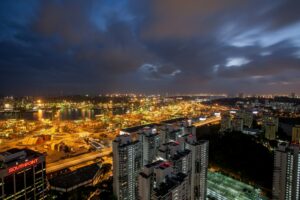India continues to grapple with the pandemic crisis, and more than ever before, there is an urgency to rebuild the nation. In this piece, Tata Communications’ Lalit Mishra, Associate Vice President, Strategic Initiatives, Internet of Things (Business Unit), explains how sustainability has to be an intrinsic part of all the development efforts that we make.
India’s growing energy demand
According to the United Nations, 68% of the world population will live in urban areas by 2050 and a whopping 416 million will be Indian. This will immensely amplify the demand for energy. 
India today is largely energy sufficient. The Government of India has made great progress in recent years in increasing citizens’ access to electricity. It is the third largest producer and consumer of electricity, with 370,348 MW installed capacity. However, our dependence on fossil fuels continues to be very high – around 62% of our energy usage.
“This is not to say that India has not made advances in the renewable energy sector. In fact, in recent years, India’s global stature has risen due to its commitment to sustainable growth. Our country’s focus is demonstrated, for example, by its role in establishing the International Solar Alliance in collaboration with France.”
The nation has set forth an ambitious target of building 175 GW of renewable energy capacity by 2022 and in line with this, has increased installed renewable capacity to 87.2 GW and solar capacity to 34 GW, up from 35 and 2.6 GW in 2014.
Important for smart street lighting to go the UJALA way
India’s infrastructure development plans are aligned to the ideas of sustainable growth and to the realities of rapidly urbanising regions.
One part of the plan is the 100 Smart Cities Mission, which is a major step in the right direction. A major urban renewal program funded by the Indian government, the Smart Cities Mission aims to develop citizen friendly and sustainable smart cities across the country. Just this year, five more cities were added to the list.
 Smart cities require smart street lighting systems, and India therefore needs a scalable smart street lighting initiative. The Indian Government’s UJALA domestic lighting initiative, which targets to replace 770 million incandescent bulbs with LED bulbs, could be used as the blueprint for this.
Smart cities require smart street lighting systems, and India therefore needs a scalable smart street lighting initiative. The Indian Government’s UJALA domestic lighting initiative, which targets to replace 770 million incandescent bulbs with LED bulbs, could be used as the blueprint for this.
Under the initiative, over 36 Cr LEDs have been installed contributing to over 47,000 million kWh energy savings, over INR 18,800 Cr cost savings, and over 3.8 Cr Tonnes of CO2 reduction every year.
“Smart street lighting systems also have a tremendous potential of saving cost and energy, reducing carbon emissions, and light-up India’s way to sustainability.”
At Tata Communications, we are committed to making a positive, tangible impact on the environment and wider society through our actions, and through our products & services for our customers. One of the ways we are doing this is through our IoT enabled solutions, like smart street lighting which helps conserve energy, reduce costs and improve the environmental footprint
Smart street lighting in action
Tata Communications has deployed smart streetlights in several cities, including Noida, NCR, Ahmedabad, Nashik, and parts of Kolkata. Delhi already has around 80,000 smart streetlights, which have been live since August 2019.
“Our smart LED light controller enables the smart streetlights to be controlled remotely, turning off or on and dimming of the light when necessary, and tracks all 80,000 lights to monitor for any malfunctions. Our biggest deployment was for a large industrial city which has 70,000 smart streetlights.”
Similarly, Tata Communications is leading the way in street lighting in Jamshedpur, with 300 smart streetlights already installed for the Jamshedpur Utilities and Services Co. Ltd (JUSCO), enabling a reduction in their carbon footprint. The aim is to increase this to 10,000 smart streetlights.
The initiative at JUSCO lead to 27 per cent energy saving over and above the standard LED energy savings due to individual consumption patterns, energy metering features and predictive maintenance. Automation such as centralised remote monitoring and control, also reduces operation and maintenance costs.
Ascertain the scale of deployment
With the scale of potential, it is important to ascertain the scale of deployment. We need to focus on the following three key aspects:
Avoid the ‘one size fits all’ approach. The diversity of Indian cities, their needs, and their challenges cannot be addressed by the modular one-size fits all approach. Therefore, while leveraging technology to solve street lighting  problems of one city, we need to customise our solutions as per the requirements of the city.
problems of one city, we need to customise our solutions as per the requirements of the city.
Mutually beneficial relationship. The citizens of India need to have a mutually beneficial and responsive relationship with new age technologies. Otherwise, even the best technological systems will be pointless. This is even applicable in the case of smart street lighting.
Singular and cohesive action plan. The challenge in India is implementation. There is a need for a multi-stakeholder partnership including private, public, and start-up companies that work cohesively towards a singular idea to make it work.
In the last few years, as sustainability has risen to the top of the agenda for companies, it’s not just cities that are looking at smart solutions. There is a demand and growing awareness from large industrial plants, commercial buildings, and townships too. For example, industrial plants are considering smart lighting solutions as they can automatically adjust the level of light depending on the time of the day, which helps with cost saving.
What can it achieve?
Smart street lighting can transform the way India travels and the way people feel about traveling in India.
If implemented as part of a sensor based IoT network, smart street lighting systems can collect data about the city which can then be used to respond to various evolving infrastructure challenges as well as create safe and illuminated spaces.
The systems not only reduce energy, cost and carbon emissions, but are also easily maintained and can provide critical help during emergencies. For example, if backed by a multi-camera and cloud service connection, the data gathered by a streetlight system can be leveraged by digital technologies to provide solutions related to traffic, crowd management and security.
Discover more about the technology that’s making the world a better place.
Transformational Hybrid SolutionsOur cloud-enablement services offer the best performance on your traffic-heavy websites or mission-critical applications.
Core NetworksTata Communications™ global IT infrastructure and fibre network delivers the resources you need, when and where you need them.
Network Resources
Unified Communications As A ServiceBreak the barriers of borders efficiently and increase productivity with Tata Communications’ UC&C solutions.
Global SIP ConnectEmpower your business with our SIP network and witness it grow exponentially.
InstaCC™ - Contact Centre As A ServiceCloud contact centre solutions for digital customers experience and agent productivity.
DIGO – Communications Platform as a ServiceDIGO is an in-network cloud communications platform, enabling you to power up converged contextual human-to-everything conversations globally.
Unified Communication Resources Case studies, industry papers and other interesting content to help you explore our unified communications solution better.
IoT SolutionsThe Internet of Things is transforming the way we experience the world around us for good. Find out more about our Internet Of Things related solutions here.
Mobility SolutionsTata Communications’ mobility services enable your enterprise to maintain seamless communication across borders, with complete visibility of cost and usage.
Mobility & IoT Resources
Multi-Cloud SolutionsWith enterprises transitioning to a hybrid multi-cloud infrastructure, getting the right deployment model that yields ROI can be a daunting task.
Cloud ComplianceCompliant with data privacy standards across different countries and is also designed to protect customers’ privacy at all levels.
IZO™ Cloud Platform & ServicesIZO™ is a flexible, one-stop cloud enablement platform designed to help you navigate complexity for more agile business performance.
Managed Infrastructure ServicesIntegrated with our integrated Tier-1 network to help your business grow efficiently across borders.
Cloud PartnersWe support a global ecosystem for seamless, secure connectivity to multiple solutions through a single provider.
Cloud Resources
Governance, Risk, and ComplianceRisk and Threat management services to reduce security thefts across your business and improve overall efficiencies and costs.
Cloud SecurityBest-in-class security by our global secure web gateway helps provide visibility and control of users inside and outside the office.
Threat Management - SOCIndustry-leading threat-management service to minimise risk, with an efficient global solution against emerging security breaches and attacks.
Advanced Network SecurityManaged security services for a predictive and proactive range of solutions, driving visibility and context to prevent attacks.
Cyber Security ResourcesCase studies, industry papers and other interesting content to help you explore our securtiy solution better.
Hosted & Managed ServicesTata Communications provide new models for efficient wholesale carrier voice service management. With our managed hosting services make your voice business more efficient and better protected
Wholesale Voice Transport & Termination ServicesYour long-distance international voice traffic is in good hands. End-to-end, voice access & carrier services which includes voice transport and termination with a trusted, global partner.
Voice Access ServicesTata Communication’s provide solutions which take care of your carrier & voice services, from conferencing to call centre or business support applications.
Carrier Services Resources
CDN Acceleration ServicesOur CDN Web Site Acceleration (WSA) solution helps deliver static and dynamic content, guaranteeing higher performance for your website.
CDN SecuritySafeguard your website data and customers’ information by securing your website from hacks and other mala fide cyber activities.
Video CDNDeliver high-quality video content to your customers across platforms – website, app and OTT delivery.
CDN Resources
Elevate CXIncrease customer satisfaction while empowering your service team to deliver world-class customer experience and engagement.
Live Event ServicesTata Communications’ live event services help battle the share if eyeballs as on-demand video drives an explosion of diverse content available on tap for a global audience.
Media Cloud Infrastructure ServicesTata Communications’ media cloud infrastructure offers flexible storage & compute services to build custom media applications.
Global Media NetworkTata Communications’ global media network combines our expertise as a global tier-1 connectivity provider with our end-to-end media ecosystem.
Use CasesUse cases of Tata Communications’ Media Entertainment Services
Remote Production SolutionsMedia contribution, preparation and distribution are highly capital-intensive for producers of live TV and video content, and their workflows are complex.
Media Cloud Ecosystem SolutionsThe Tata Communications media cloud infrastructure services offer the basic building blocks for a cloud infrastructure-as-a-service.
Global Contribution & Distribution SolutionsTata Communications’ global contribution and distribution solution is built to reduce capital outlay and grow global footprint.
Satellite Alternative SolutionsAs more and more consumers choose to cut the cord & switch to internet-based entertainment options, broadcasters are faced with capital allocation decisions.
LeadershipA look into the pillars of Tata communications who carry the torch and are living embodiment of Tata’s values and ethos.
Culture & DiversityHere at Tata Communications we are committed to creating a culture of openness, curiosity and learning. We also believe in driving an extra mile to recognize new talent and cultivate skills.
OfficesA list of Tata Communications office locations worldwide.
SustainabilityTata Communications adopts a holistic approach and harnesses the power of new-age technologies like 5G, IoT and AI to build a sustainable digital world.
FAQCheck out our FAQs section for more information.
BoardHave a look at our board of members.
ResultsFind out more about our quarterly results.
Investor PresentationsFollow our repository of investor presentations.
FilingsGet all information regarding filings of Tata communications in one place.
Investor EventsAll investor related event schedule and information at one place.
GovernanceAt Tata, we believe in following our corporate social responsibility which is why we have set up a team for corporate governance.
SharesGet a better understanding of our shares, dividends etc.
SupportGet all investor related contact information here.


